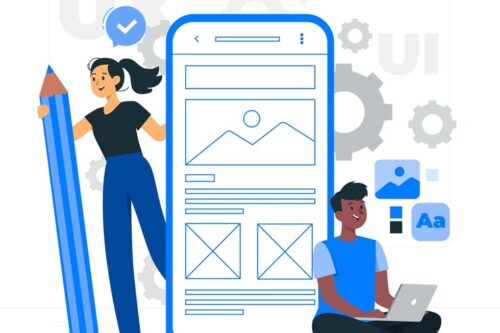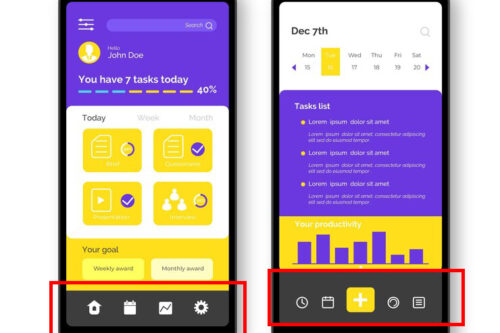Some UX designers are still not sure which method to choose to show their content for their page. Each method has its strengths and weaknesses, and in this article, we will look at the two methods and decide which one to use for our projects.
Infinite Scroll
Endless scrolling is a technology that allows users to scroll through much of the content without seeing the finish line. This technology simply keeps the page updated when you scroll down. As flattering as it may seem, technology is not a complete solution for every website or app.
Pros # 1: user interaction and content discovery
When you use scrolling as the primary way to explore data, you can make the user stay longer on your web page, increasing interactivity. With the spread of social media, large amounts of data are being consumed. Endless scrolling provides a powerful way to explore this ocean of information, without having to wait for pages to load preloaded.
Endless scrolling is almost a must-have feature of discovery interfaces. When the user is not looking for something specific, they need to see a large number of items to find the only thing they like.
You can assess the benefits of endless scrolling with an example from a Facebook news feed. Under a tacit agreement, users are aware that they won’t be able to see everything in the feed because the content is updated frequently. With endless swiping, Facebook goes to great lengths to reveal as much information as possible to users as they scanning and consume this flow of information.
Pros # 2: scrolling is better than clicking
Users have better scrolling experiences than click/click. Mouse wheels or touchscreens make scrolling faster and easier to click. For long, continuous content, such as a tutorial, scrolling provides better use of the anatomy of text on multiple screens or separate pages.
Pros # 3: good scrolling for mobile devices
The smaller the screen, the longer the scroll. Generalizing mobile navigation is another important support for the long pass. Mobile gesture controls make scrolling intuitive and easy to use. As a result, users enjoy a real responsive experience, regardless of the device they use.
Cons # 1: Page performance and device resources
Page loading speed is everything for good user experience. Multiple types of research have shown that slow load times lead people to leave your site or remove your application, resulting in lower conversion rates. This is bad news for those who use endless scrolling. The more users scroll down a page, the more content will have to load on the same page. As a result, page performance will slow down even further.
Another problem is the limited resources of the user’s device. At many endless scrolling sites, especially those with lots of images, devices with limited resources like the iPad may start to dwindle due to a large number of assets loaded.
Cons #2: Search for items and location
Another problem with infinite scrolling is that when users reach a certain point in the sequence, they can’t bookmark their site and come back to it later. If they leave the site, they will lose all their progress and will have to scroll down again to return to the same place. Not being able to locate the user’s scrolling position not only bothers or confuses users but also damages the overall user experience.
In 2012 Etsy spent time implementing the infinite scroll interface and found that the new interface didn’t work as well as page numbering. Although the number of purchases remained almost the same, user interaction has decreased, people have not used much research now.
Dmitry Vadiyev also notes, “People will want to go back to the search results list to verify the items they just saw and compare them to what they found elsewhere below the list. Infinite slip not only breaks this dynamic, but It also makes it difficult to move the list up and down, especially when you return to the page at another time and are at the top, where you need to scroll down the list once more and wait for the results to load. In this way, the endless scrolling interface is slower than the paged interface.
Cons #3: the slider is irrelevant
Another annoying thing is that the scroll bars do not reflect the actual amount of data available. You will scroll down happily assuming you are near the bottom, which in itself tempts you to scroll a bit further, only to find that the results have only doubled by the time you get there. From the point of view of accessibility, it is very bad to break the use of scroll bars for users.
Cons #4: without footer
There are appendices for a reason: they contain content that the user sometimes needs – if users can’t find something or want additional information, they often do. But as the feed goes on infinitely, more data is loaded once the user reaches the end, moving the footer away from serving each time.
–When LinkedIn introduced endless scrolling in 2012, users were able to see a screen before uploading new stories.–
Sites that implement unlimited scrolling should make the footer accessible by sticking it or moving links to a top or sidebar.
–Facebook moves all links from the footer (such as “Legal” and “Careers”) to the right sidebar.–
Another solution is to download content on-demand using the download more button. New content will not load automatically until the user clicks the More button. This way, users can easily access their footer without having to chase it.
–Instagram uses the “Upload more” button to facilitate user access to the footer–
Pagination
Pagination is a user interface style that breaks content into separate pages. If you scroll to the bottom of the page and see the row of numbers, this row of numbers is the page numbering for the site or app.
Pros # 1: good conversion
Pagination is good when a user specifically searches for something within the list of results, it not only checks the flow and consumption of information.
You can measure the benefits of page numbering using the Google search example. Searching for the best search result can take a second or an hour, depending on your search. But when you decide to stop searching in Google’s current format, you know the exact number of search results. You can decide where to stop or how many results you can see.
Pros # 2: Feeling in control
Endless scrolling is like an endless game: no matter how much scrolling, you feel like you will never get to the end. When users know how many results are available, they can make a more informed decision, rather than letting them search for an endless scrolling list.
According to research by David Cierce Psychology in Human-Computer Interaction: “Reaching an endpoint provides a sense of control.”
The search also shows that when users have limited but still relevant results, they can determine if what they are looking for is there or not.
Also, when users see the total amount of results (of course, when the total amount of data is unlimited) they will be able to estimate the amount of time it took them to find what they were really looking for.
Pros # 3: item location
A paged interface allows the user to maintain the mental location of an object. They may not necessarily know the exact page number of the page, but they will almost remember what it was and the broken links will allow them to easily access them.
With page numbering, users control navigation because they know which page they are clicking to return to where they are.
Pagination is good for e-commerce sites and applications. When users shop online, they want to be able to go back to where they left off and continue shopping.
Cons: additional actions
To access the next page in the page numbering, the user must find the purpose of the link (such as “Next”), hover over it, click and wait for the new page to load.
The main problem here is that most sites offer very limited content to users with only one page. By making your pages longer without compromising download speed, users will get more content per page and won’t have to click or click the pagination button.
When to use endless scrolling/paging?
There are only a few cases where infinite scrolling is effective. It is best suited for websites and applications that are streams of user-generated content (Twitter, Facebook, Pinterest, Instagram). On the other hand, page numbering is suitable for goal-oriented sites and applications.
Google’s experience is a good example of this point. Google Images uses endless scrolling because users can scan and manipulate images faster than text. The search result takes longer to read. This is why Google search results still use traditional paging technology.
conclusion
Designers must weigh the pros and cons of endless scrolling and number before choosing one. The choice depends on your design context and how this content is presented. In general, endless scrolling works well for something like Twitter, as users consume an endless stream of real-time generated data without searching for anything in particular, while the migration interface is good for search result pages where people search for a specific item and Where the location of all items the user saw is important.


